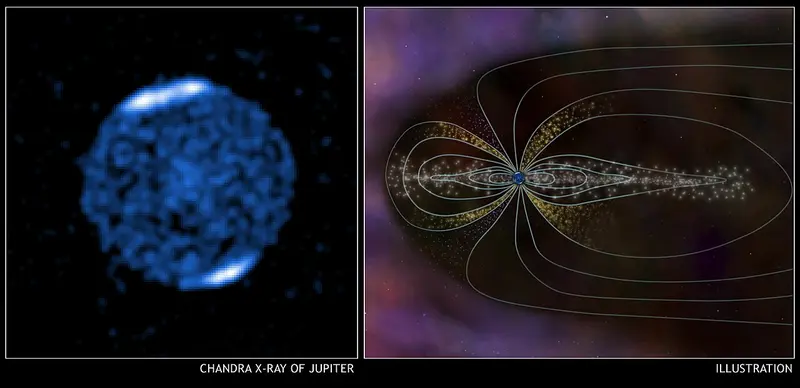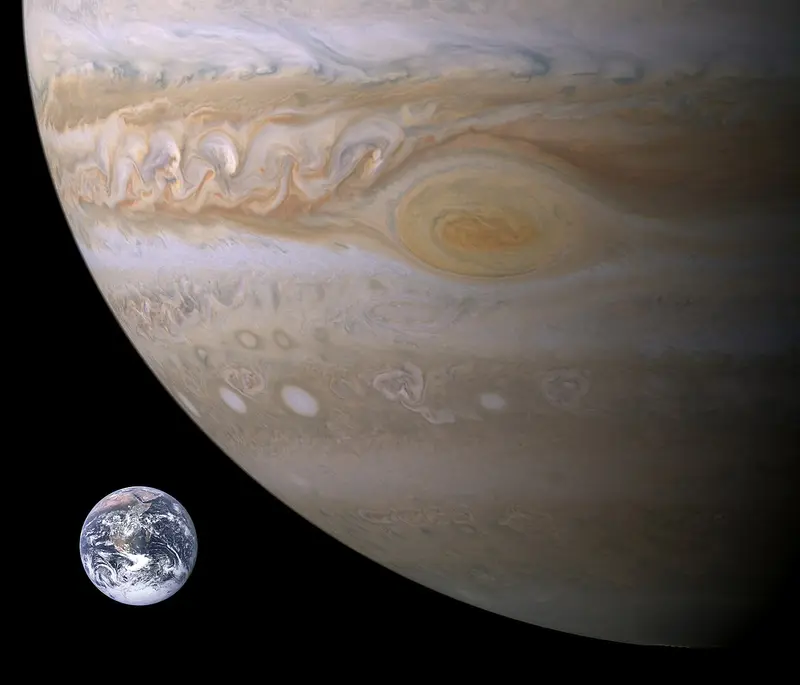The gas giant Jupiter is the largest planet. Solar system and the fifth planet from the Sun in terms of distance. But if Jupiter has no surface, then what does it have? Let’s try to figure it out together with Benjamin Roulston, a professor at Clarkson University (USA).
“As a physics professor studying various unusual phenomena, I understand that the concept of a planet without a surface is hard to grasp,” he noted. According to Mr. Roulston, much about Jupiter remains a mystery, particularly the fact that NASA’s robotic probe Juno has been orbiting this strange planet for nine years.
A few more interesting facts.
Jupiter’s place is between Mars and Saturn This planet is so large that it can hold more than 1000 Earths, with room to spare. Jupiter’s mass is two and a half times greater than the mass of all the other planets in the Solar System combined.
While the four inner planets of the Solar System – Mercury, Venus, Earth, and Mars – are made of solid, rocky material, Jupiter is a gas giant with a composition similar to Sun This is a stormy, wildly turbulent ball of gas. In some areas on Jupiter, winds blow at speeds of about 640 kilometers per hour, which is roughly three times faster than a Category 5 hurricane on Earth.
In search of solid ground
If you start moving from the upper layers of the atmosphere Lands In her direction, the air pressure will continuously rise. Eventually, we will reach the surface of our planet – land or water.
According to Professor Rawlston, the situation with Jupiter is quite different. If you start moving from the upper part of its atmosphere, which is primarily composed of hydrogen and helium, the pressure will also gradually increase. But on Jupiter, it is colossal! As the layers of gas press down more and more, it will feel as if we are at the bottom of an ocean, but surrounded not by water, but by gas. Eventually, the pressure will become so immense that the human body will explode.
If you descend 1600 kilometers, the hot, dense gas will start to behave strangely. Eventually, it will turn into a liquid form of hydrogen, creating what can be considered the largest ocean in the Solar System, albeit one without water.
And if you go down another 32,000 km, hydrogen will resemble a flowing liquid metal more closely, a material that is extremely exotic: scientists have only recently and with great effort recreated it in the laboratory. The atoms in this liquid metallic hydrogen are compressed so tightly that its electrons can move freely.
These layer transitions are gradual, not abrupt. The transition from ordinary gaseous hydrogen to liquid, and then to metallic, occurs slowly and smoothly. At no point is there a sharp boundary, solid material, or surface.

Jupiter’s radiation in the gamma range
Terrifying to the depths of the soul.
Eventually, we will reach the core of Jupiter. This is the central area of its interior – it should not be confused with the surface. Scientists are still debating the exact nature of the material in this core. The optimal answer is that it is not a solid substance like rock, but rather a hot, dense, and possibly metallic mixture of liquid and solid material.
The pressure in Jupiter’s core is extraordinarily high – 100 million Earth atmospheres, which is comparable to the pressure of two Empire State Buildings on every square inch of our body.
But pressure is not the only problem. A spacecraft attempting to reach the core of Jupiter would melt from the extreme heat – 20,000 degrees Celsius. This is three times hotter than the surface of the Sun, the publication reported. Science Alert .
Jupiter protects our Earth.
Jupiter is a strange and repulsive place. But if it didn’t exist, humans might not exist either. This is because Jupiter acts as a shield for the planets of the Solar System, particularly Earth. Due to its immense gravitational pull, Jupiter alters the orbits. asteroids and comets over billions of years.
Without Jupiter’s intervention, part of this space debris could have collided with Earth, explained Professor Roulston. And if the collision had been catastrophic, it could have caused extinction, just like when the dinosaurs went extinct.

Comparative sizes of Earth and Jupitera
However, although Jupiter protected Earth, it still remained uninhabitable – at least in the way we know life.
A completely different story is with Europa, one of Jupiter’s moons, which may be our best chance of finding life elsewhere in the Solar System. NASA’s Europa Clipper spacecraft, launched on October 14 of this year, is set to make about 50 flybys of this moon to study its vast underground ocean.
I wonder if there is life in the waters of Europa? Scientists won’t find out for some time. Due to Jupiter’s distance from Earth, NASA’s probe won’t arrive there until at least April 2030.

